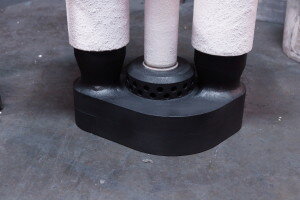Re-use of a Graphite Pump - Not a Warped Idea!
Unlike stainless steel pumps, graphite pumps can be quickly and easily reintroduced into the molten metal bath, and the pump will operate with the same efficiency as when removed from the melt. This capability is because graphite retains its structural and dimensional integrity while stainless steel becomes flexible and deforms at molten metal operating temperatures. Once removed from the metal bath, especially an aluminum bath, the stainless steel pump must be discarded due to excessive deformation.Molten metal pump base showing posts, shaft, shaft bearing, and base all made of graphite treated with a proprietary oxidation inhibitor process not available elsewhere.
Construction
The above photo shows a new molten metal pump base destined for an aluminum transfer application. All the submerged structural components are constructed from specially treated graphite. The proprietary graphite treatment radically reduces oxidation rates of the graphite and helps prevent moisture penetration before introduction to the molten metal. During the normal operating lifecycle, the graphite remains dimensionally stable while the structural integrity will slow diminish as the graphite sublimates. The higher the melt temperature the fast the graphite will sublimate. Fortunately, regular visual inspection can readily identify graphite loss and trigger a pump maintenance cycle.
Moisture and Storage
Graphite is hygroscopic. It attracts and holds moisture. Graphite molten metal pump components must be stored well above the dew point and never in direct contact with the floor and especially a concrete floor. The concrete floor is a source of moisture, and the floor temperature will be conducted through the thermally conductive graphite cause the entire assembly to cool to the temperature of the floor.Metal coated graphite shaft sleeve and riser.
Pump Removal
When a pump is removed from the molten metal bath, excess metal must be gently removed. The removal of excess metal is particularly critical for aluminum pumps because the aluminum will contract, shrink, and pull back from the graphite. If the residual aluminum is in excess, the cooling aluminum can cause damaging stresses to form and break the graphite. The small amount of residual metal between the bearings will also contract, releasing the bearings to allow disassembly during a maintenance cycle. Once the pump is cool, it is recommended to gently remove all loose aluminum with damaging the graphite. This will aid in restarting the pump later.
Storage
For periods of a few hours, the pump can be kept out of the melt and out of a pre-heat station provided it is a dry environment. After a pump as been subjected to molten metal temperatures, it becomes much less tolerant of moisture. Graphite becomes more hygroscopic as does the bearing material, but the bearing material will expand with the accumulation of moisture causing severe damage to the pump components. To prevent this costly damage, use a pre-heat station to store pump components and pumps after exposure to the molten metal.
Returning the Pump to the Melt
If a pump is removed, but not allowed to cool below 300F, it can be re-introduced into the melt over the course of a few minutes. This is because moisture will not have accumulated. If a pump is allowed to cool fully, then moisture precautions must be taken. Ideally, the pump would be pre-heated in a pre-heat station to at least 300F for 90 minutes prior to beginning re-introduction. This bake-out step is required to remove the moisture that may have accumulated. Refer to the pump manual for details and precautions regarding pump installation. Pumps repaired with a new transfer assembly should be treated as a new pump for dry-out and preheating purposes. See manual for guidance.WARNING - GRAPHITE CONTAINING MOISTURE MAY EXPLODE IN MOLTEN METAL!PLEASE REFER TO THE MANUAL THAT SHIPPED WITH YOUR MOLTEN METAL PUMP FOR COMPLETE SAFETY INFORMATION.


